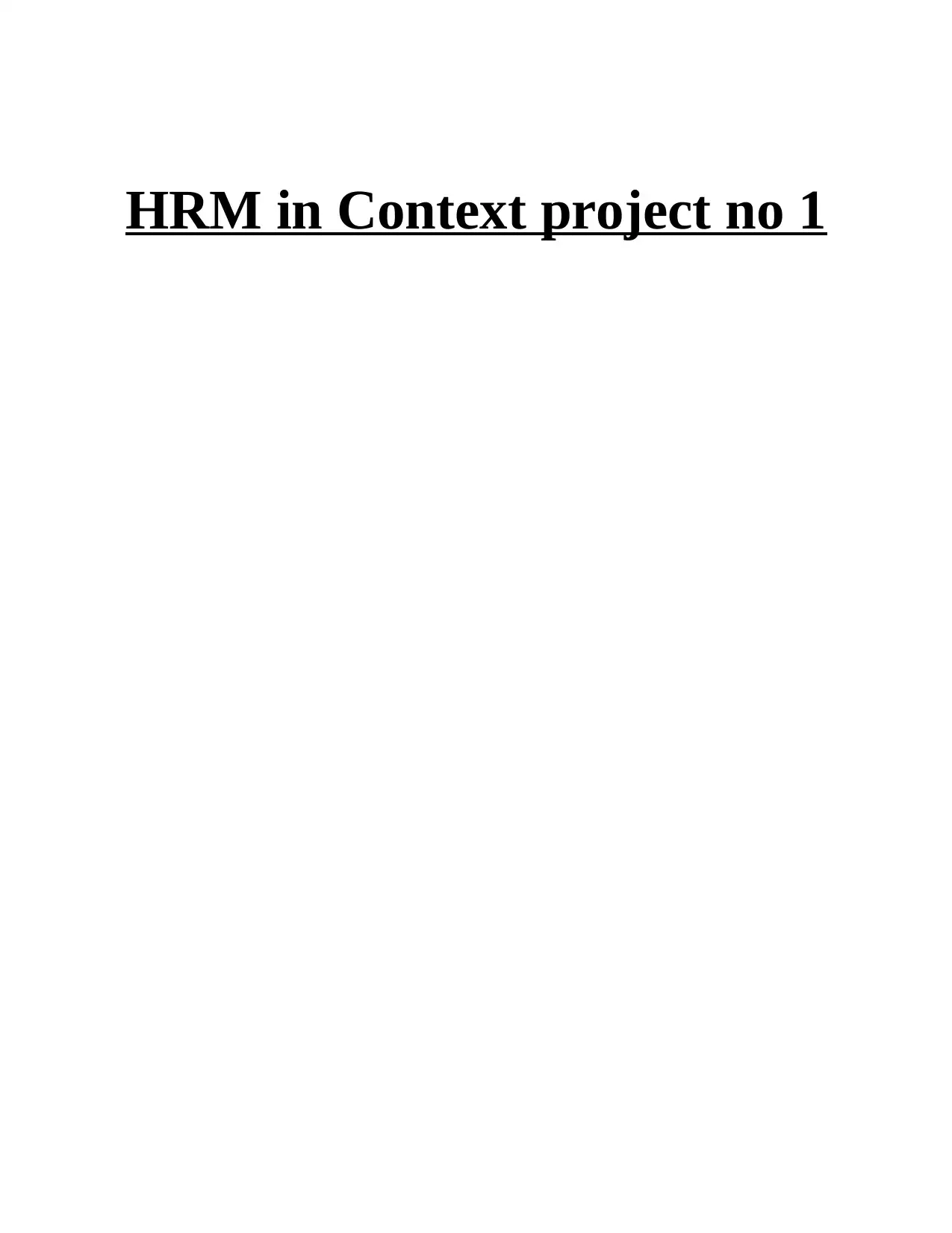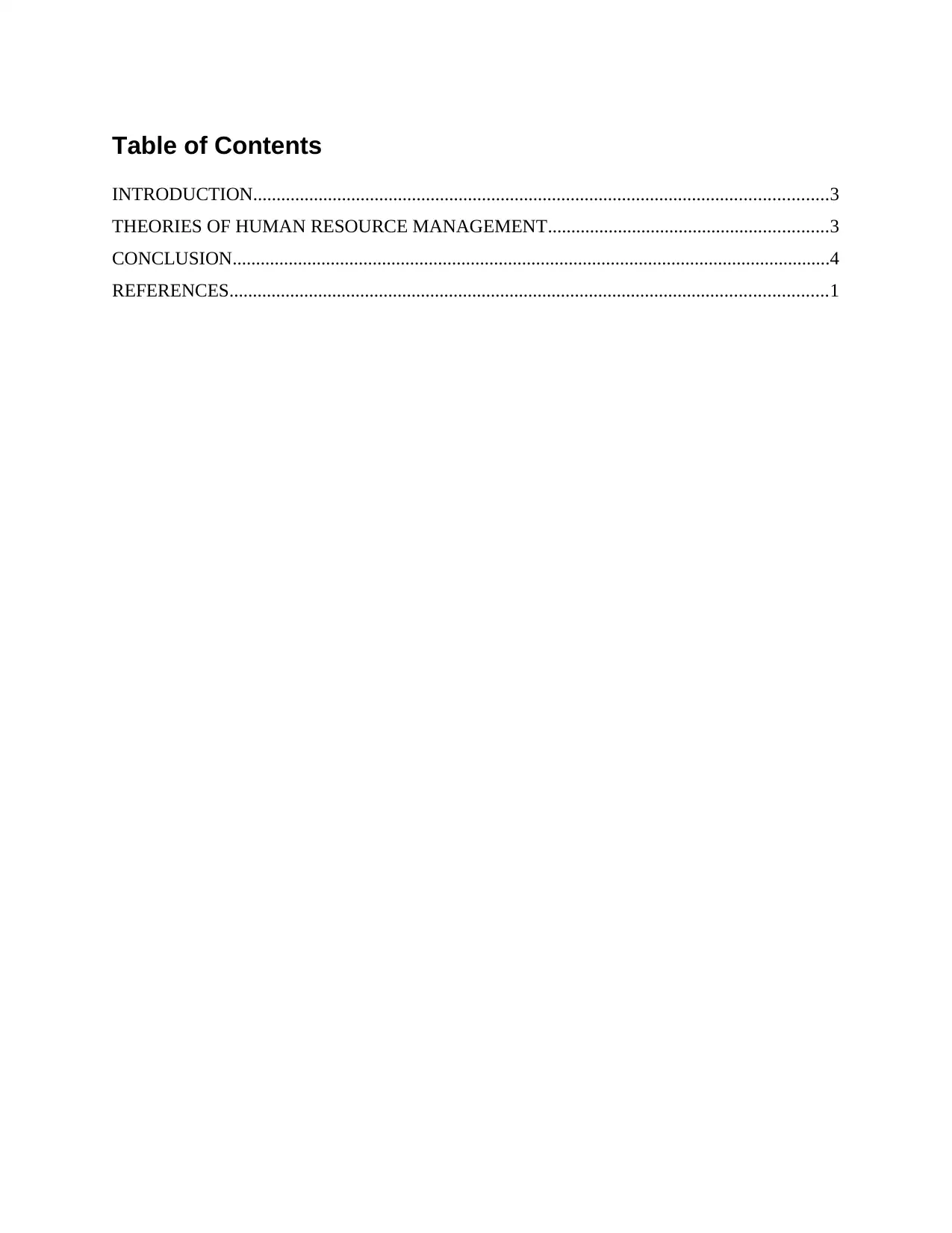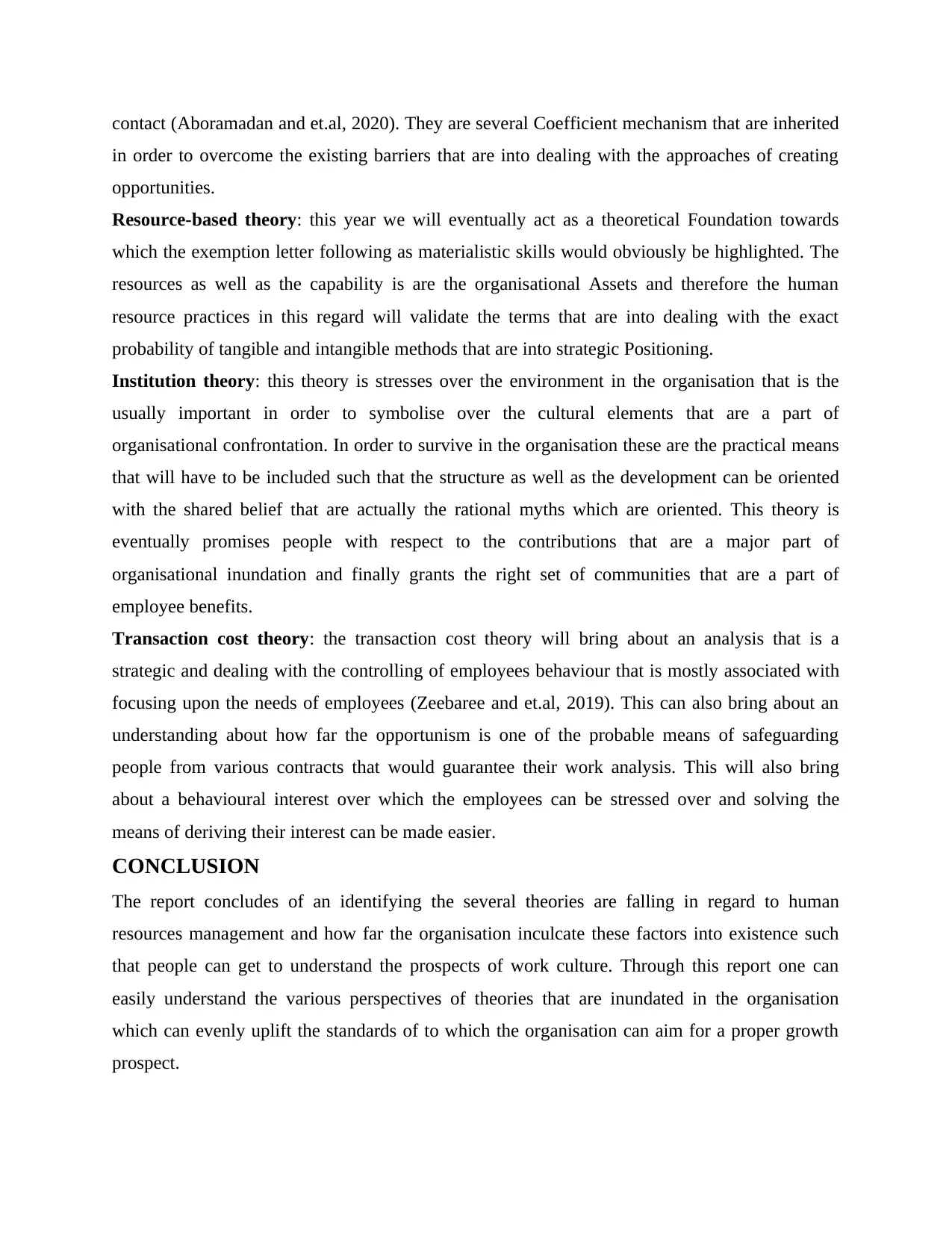Human Resource Management Theories in Context: Project Report
VerifiedAdded on 2023/06/14
|5
|985
|133
Report
AI Summary
This report provides a comprehensive overview of Human Resource Management (HRM) theories and their application within organizational contexts. It delves into theories such as organizational behavior theory, which focuses on understanding employee perspectives and fostering a rewarding culture; motivation theory, which highlights the importance of fulfilling individual needs to achieve organizational goals; human capital theory, emphasizing investment in employees for economic productivity; resource-based theory, which views human resources as valuable organizational assets; institution theory, which stresses the importance of cultural elements for organizational survival; and transaction cost theory, which analyzes employee behavior and safeguards their interests. The report concludes by emphasizing the importance of these theories in understanding work culture and promoting organizational growth. Desklib offers this and many other solved assignments for students.

HRM in Context project no 1
Paraphrase This Document
Need a fresh take? Get an instant paraphrase of this document with our AI Paraphraser

Table of Contents
INTRODUCTION...........................................................................................................................3
THEORIES OF HUMAN RESOURCE MANAGEMENT............................................................3
CONCLUSION................................................................................................................................4
REFERENCES................................................................................................................................1
INTRODUCTION...........................................................................................................................3
THEORIES OF HUMAN RESOURCE MANAGEMENT............................................................3
CONCLUSION................................................................................................................................4
REFERENCES................................................................................................................................1

INTRODUCTION
Human resources management is said to be one of the key component in the organisation and it
is brought forward with respect to several identities that are usually incorporated (Ozkeser,
2019). One might seriously not be able to deal with hexagon toys unless and until there are
certain measures that are followed and thus the human resources management in the organisation
will deal with the employee management as well as different orientation that are a part of
organisational entity.
THEORIES OF HUMAN RESOURCE MANAGEMENT
Including human resources management There are several theories that will fall in regard to
bring about a complete orientation about how far one might eventually deal with the
circumstances in an organisation. This theoretical component would often highlight how far the
human resources management in the organisation will entitle the strategic development as well
as the employment criteria.
The organisation behaviour theory: the organisational behaviour theory would eventually help
to understand the different perspectives of the organisation that are falling in regard to people
(Diaz‐Carrion and et.al, 2021). There are several anticipations that are brought forth with a
realistic recognition of employees and therefore this dedication towards the fact that it will act as
a rewarding criterion will be helpful in dealing with the circumstances of culture. The
organisational behaviour theory illustrate upon quality and justice that is brought forth with
respect to the systems that are validated in the organisation.
Motivation theory: the motivation theory in the organisation will create a kind of passion that is
necessary for attaining organisational goals. It is also a condition that will fulfil several needs
that are following in regard to individuals which is also coming under Moslows Hierarchy of
needs. To accomplish the targets as well as objective of the organisation this motivation will be a
determining factor and unemployment skill that is to be inculcated such that the academic
literature that are following in regard to creating a business and management can therefore be
made productive.
Human capital theory: the human capital theory will revolve around the investment that is put
forth which will eventually reflect over the economic productivity. This theory will also state
that the human capital which is known to be one of the instrumental need for people in the
organisation will correlate with several factors like that of multiple regression that are variable
Human resources management is said to be one of the key component in the organisation and it
is brought forward with respect to several identities that are usually incorporated (Ozkeser,
2019). One might seriously not be able to deal with hexagon toys unless and until there are
certain measures that are followed and thus the human resources management in the organisation
will deal with the employee management as well as different orientation that are a part of
organisational entity.
THEORIES OF HUMAN RESOURCE MANAGEMENT
Including human resources management There are several theories that will fall in regard to
bring about a complete orientation about how far one might eventually deal with the
circumstances in an organisation. This theoretical component would often highlight how far the
human resources management in the organisation will entitle the strategic development as well
as the employment criteria.
The organisation behaviour theory: the organisational behaviour theory would eventually help
to understand the different perspectives of the organisation that are falling in regard to people
(Diaz‐Carrion and et.al, 2021). There are several anticipations that are brought forth with a
realistic recognition of employees and therefore this dedication towards the fact that it will act as
a rewarding criterion will be helpful in dealing with the circumstances of culture. The
organisational behaviour theory illustrate upon quality and justice that is brought forth with
respect to the systems that are validated in the organisation.
Motivation theory: the motivation theory in the organisation will create a kind of passion that is
necessary for attaining organisational goals. It is also a condition that will fulfil several needs
that are following in regard to individuals which is also coming under Moslows Hierarchy of
needs. To accomplish the targets as well as objective of the organisation this motivation will be a
determining factor and unemployment skill that is to be inculcated such that the academic
literature that are following in regard to creating a business and management can therefore be
made productive.
Human capital theory: the human capital theory will revolve around the investment that is put
forth which will eventually reflect over the economic productivity. This theory will also state
that the human capital which is known to be one of the instrumental need for people in the
organisation will correlate with several factors like that of multiple regression that are variable
⊘ This is a preview!⊘
Do you want full access?
Subscribe today to unlock all pages.

Trusted by 1+ million students worldwide

contact (Aboramadan and et.al, 2020). They are several Coefficient mechanism that are inherited
in order to overcome the existing barriers that are into dealing with the approaches of creating
opportunities.
Resource-based theory: this year we will eventually act as a theoretical Foundation towards
which the exemption letter following as materialistic skills would obviously be highlighted. The
resources as well as the capability is are the organisational Assets and therefore the human
resource practices in this regard will validate the terms that are into dealing with the exact
probability of tangible and intangible methods that are into strategic Positioning.
Institution theory: this theory is stresses over the environment in the organisation that is the
usually important in order to symbolise over the cultural elements that are a part of
organisational confrontation. In order to survive in the organisation these are the practical means
that will have to be included such that the structure as well as the development can be oriented
with the shared belief that are actually the rational myths which are oriented. This theory is
eventually promises people with respect to the contributions that are a major part of
organisational inundation and finally grants the right set of communities that are a part of
employee benefits.
Transaction cost theory: the transaction cost theory will bring about an analysis that is a
strategic and dealing with the controlling of employees behaviour that is mostly associated with
focusing upon the needs of employees (Zeebaree and et.al, 2019). This can also bring about an
understanding about how far the opportunism is one of the probable means of safeguarding
people from various contracts that would guarantee their work analysis. This will also bring
about a behavioural interest over which the employees can be stressed over and solving the
means of deriving their interest can be made easier.
CONCLUSION
The report concludes of an identifying the several theories are falling in regard to human
resources management and how far the organisation inculcate these factors into existence such
that people can get to understand the prospects of work culture. Through this report one can
easily understand the various perspectives of theories that are inundated in the organisation
which can evenly uplift the standards of to which the organisation can aim for a proper growth
prospect.
in order to overcome the existing barriers that are into dealing with the approaches of creating
opportunities.
Resource-based theory: this year we will eventually act as a theoretical Foundation towards
which the exemption letter following as materialistic skills would obviously be highlighted. The
resources as well as the capability is are the organisational Assets and therefore the human
resource practices in this regard will validate the terms that are into dealing with the exact
probability of tangible and intangible methods that are into strategic Positioning.
Institution theory: this theory is stresses over the environment in the organisation that is the
usually important in order to symbolise over the cultural elements that are a part of
organisational confrontation. In order to survive in the organisation these are the practical means
that will have to be included such that the structure as well as the development can be oriented
with the shared belief that are actually the rational myths which are oriented. This theory is
eventually promises people with respect to the contributions that are a major part of
organisational inundation and finally grants the right set of communities that are a part of
employee benefits.
Transaction cost theory: the transaction cost theory will bring about an analysis that is a
strategic and dealing with the controlling of employees behaviour that is mostly associated with
focusing upon the needs of employees (Zeebaree and et.al, 2019). This can also bring about an
understanding about how far the opportunism is one of the probable means of safeguarding
people from various contracts that would guarantee their work analysis. This will also bring
about a behavioural interest over which the employees can be stressed over and solving the
means of deriving their interest can be made easier.
CONCLUSION
The report concludes of an identifying the several theories are falling in regard to human
resources management and how far the organisation inculcate these factors into existence such
that people can get to understand the prospects of work culture. Through this report one can
easily understand the various perspectives of theories that are inundated in the organisation
which can evenly uplift the standards of to which the organisation can aim for a proper growth
prospect.
Paraphrase This Document
Need a fresh take? Get an instant paraphrase of this document with our AI Paraphraser

REFERENCES
Books and journals
Aboramadan and et.al, 2020. Human resources management practices and organizational
commitment in higher education: The mediating role of work engagement. International
Journal of Educational Management.
Diaz‐Carrion and et.al, 2021. Constructing an index for comparing human resources
management sustainability in Europe. Human Resource Management Journal. 31(1).
pp.120-142.
Ozkeser, 2019. Impact of training on employee motivation in human resources management.
Procedia Computer Science. 158. pp.802-810.
Zeebaree and et.al, 2019. Human resource management systems for enterprise organizations: A
review. Periodicals of Engineering and Natural Sciences (PEN). 7(2). pp.660-669.
Online
Human resources management, 2021: [Online]. Available through: < Human Resource
Management: What Is It? (thebalancecareers.com) >
1
Books and journals
Aboramadan and et.al, 2020. Human resources management practices and organizational
commitment in higher education: The mediating role of work engagement. International
Journal of Educational Management.
Diaz‐Carrion and et.al, 2021. Constructing an index for comparing human resources
management sustainability in Europe. Human Resource Management Journal. 31(1).
pp.120-142.
Ozkeser, 2019. Impact of training on employee motivation in human resources management.
Procedia Computer Science. 158. pp.802-810.
Zeebaree and et.al, 2019. Human resource management systems for enterprise organizations: A
review. Periodicals of Engineering and Natural Sciences (PEN). 7(2). pp.660-669.
Online
Human resources management, 2021: [Online]. Available through: < Human Resource
Management: What Is It? (thebalancecareers.com) >
1
1 out of 5
Related Documents
Your All-in-One AI-Powered Toolkit for Academic Success.
+13062052269
info@desklib.com
Available 24*7 on WhatsApp / Email
![[object Object]](/_next/static/media/star-bottom.7253800d.svg)
Unlock your academic potential
Copyright © 2020–2025 A2Z Services. All Rights Reserved. Developed and managed by ZUCOL.




